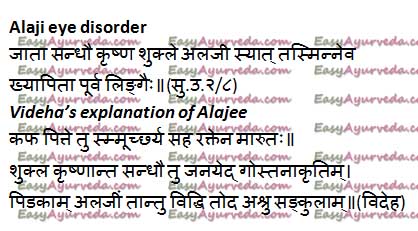Alaji Eye Disorder Definition, Location, Symptoms, Treatment
Article by Dr Raghuram Y.S. MD (Ay) & Dr Manasa, B.A.M.S
Alaji is an eye disorder affecting the Sclero-corneal Junction (junction or meeting place of black and white of the eye). It is correlated with Marginal ulcers of Cornea (Keratitis Marginalis), Keratitis Marginalis Profunda, Diciform Keratitis and Phlyctenule (Phlyctenular keratoconjunctivitis)
Table of Contents
Introduction
Alaji – Quick look about the disease
Location – Netra – Eye
Specific location – Krishna-Shukla Gata Sandhi – Sclero-corneal Junction (junction or meeting place of black and white of the eye)
Classification based on the location – Alajee is a Sandhigata Roga i.e. disease occurring in the junction of the eye
Related reading – Netra Sandhi Gata Rogas
Classification based on Predominant Dosha – Alaji is a Sannipataja Netra Roga i.e. caused by simultaneous vitiation of all the three doshas
Classification based on Sadhya Asadhyata (prognosis) – Alaji is an Asaadhya roga i.e. incurable disease
Classification based on predominant treatment / surgical process used in combating the disease – Since Alaji is an Asadhya Netra roga i.e. incurable eye disease of netra sandhi, no treatment has been mentioned for this condition in the form of medicinal formulations or surgical interventions.

Definition, meaning
Alaji, definition and meaning
Alaji is a thick, circular, red colored swelling (protuberance, growth) occurring at the sclera-corneal junction of the eye, i.e. at the junction of the black portion and white portion of the eye (Krishna-shuklagata sandhi).
Alaji – A similar swelling resembling Parvani which occurs in the Krishna-shukla gata sandhi which is thick and stout (in comparison to thin swelling in parvani) is called Alaji. It has the same symptoms as that of Parvani.
Alajee, like Parvani is a netra sandhigata roga (diseases occurring at the junctions of the eye parts) and occurs at the same place where Parvani occurs. Parvani is a thin circular swelling (protuberance, growth) but Alaji is a thick protuberance (this being the only difference between parvani and alaji). The color of the protuberance is coppery red as in Parvani. Parvani is caused by vitiated rakta (blood) but Alajee is caused due to simultaneous vitiation of all three doshas (sannipataja).
Just like in Parvani, Alajee is also associated with burning sensation and pain at the region of the swelling.
Videha’s explanation of Alajee
Vitiated Vata getting admixed (associated) with vitiated kapha, pitta and rakta (blood), gets lodged in the shukla-krishna gata sandhi (junction of the white of the eye and black of the eye i.e. sclero-corneal junction). On getting lodged in this area they produce an eruption (blister) of the shape of the breast of a cow (gostana). This condition is associated with pricking pain and severe discharge of tears (collection of tears) and is called Alajee.
Symptoms
Symptoms of Alajee
Vritta Shopha – thick, circular swelling (protuberance, growth) occurs at the junction of Krishna bhaga (black of the eye, iris) and shukla bhaga (white of the eye, sclera)
Gostanakara pidika – blister (eruption) of the shape of a cow’s breast
Tamra – the swelling is of coppery red colour
Dahopapanna – presence of burning sensation over the protuberance
Shulopapanna – pain in the growth
Toda – pricking pain
Ashru sankulam – collection of (discharge) of tears
Modern correlation
Alaji can be correlated to –
- Marginal ulcers of Cornea (Keratitis Marginalis)
- Keratitis Marginalis Profunda
- Diciform Keratitis
- Phlyctenule (Phlyctenular keratoconjunctivitis)
Phlectenule – is a characteristic nodular affection occurring as an allergic response of the conjunctival and corneal epithelium to some endogenous allergens to which they have become sensitized.
Phlectenular keratoconjunctivitis (phlyctenulosis) is an inflammatory syndrome caused by a delayed hypersensitivity reaction to one or more allergens. The triggering allergen is usually a bacterial protein (particularly from Staphylococcus aureus), but may also be a virus, fungus (particularly Candida albicans) or nematode.
Though this condition occurs at the junction of conjunctiva and cornea, we can consider conjunctiva as Krishna bhaga (conjunctiva covering the sclera, ending near cornea) and cornea as Krishna bhaga (though cornea is transparent, the black of the eye i.e. iris, is seen through it). Thus, the above said conditions can be compared to Alajee.
Treatment
Treatment of Alajee
Since Alajee is an Asaadhya Netra Roga i.e. incurable eye disorder, medicinal or surgical treatments have not been explained for Alaji.
Click to Consult Dr Raghuram Y.S. MD (Ayu) – Email / Skype









